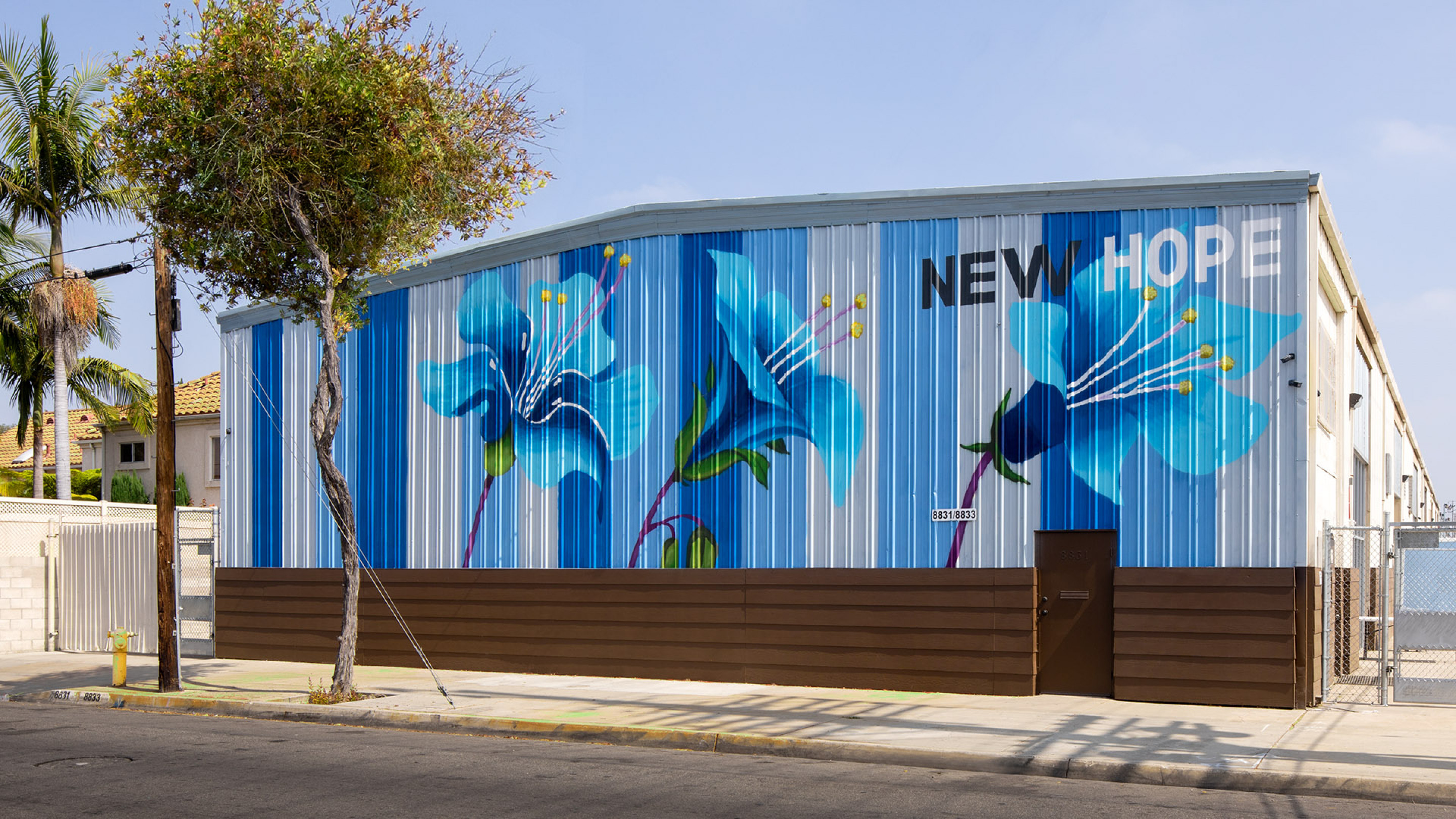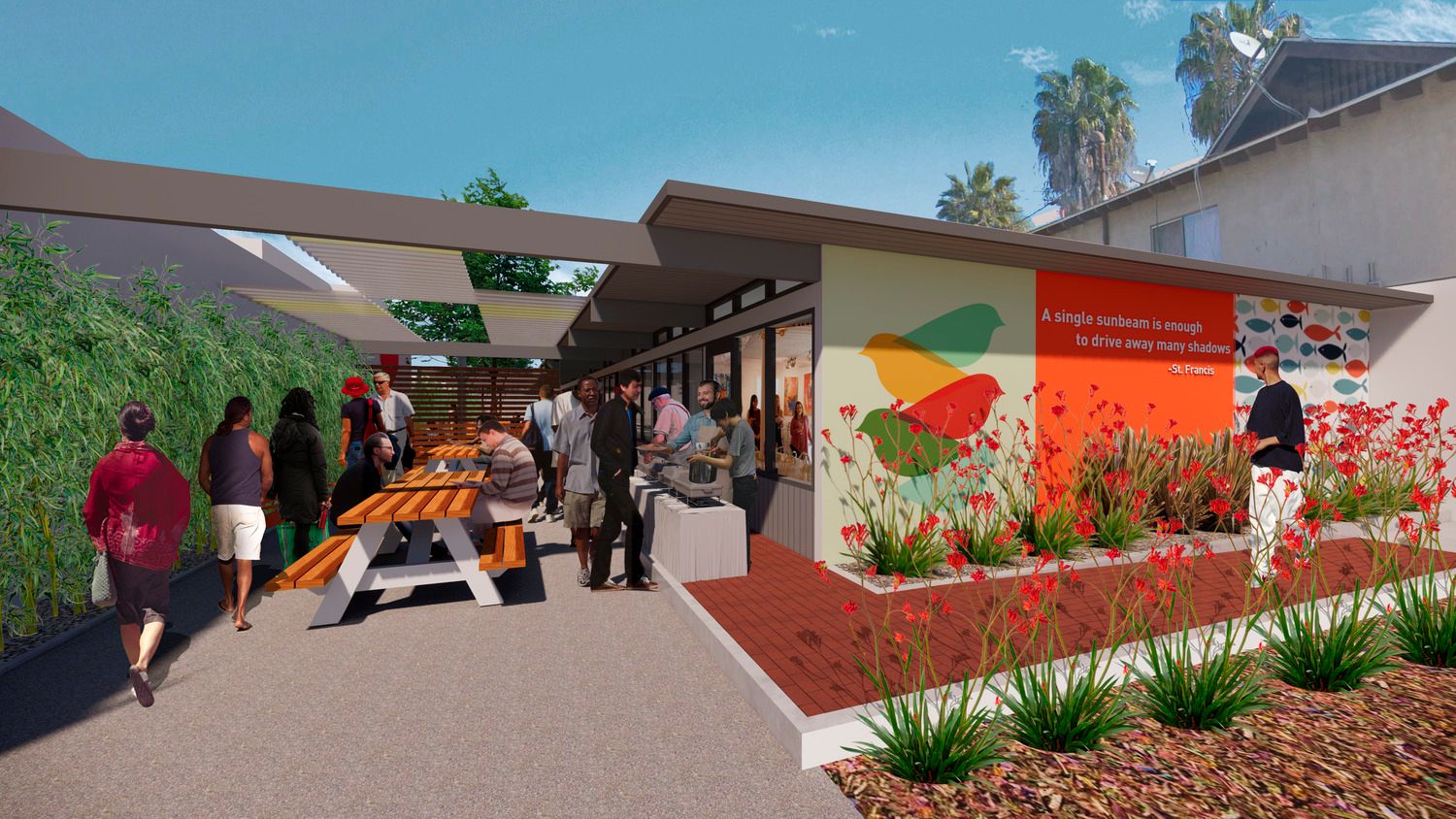Compelled by federal court order to make appropriate shelter available to its unhoused residents or halt enforcement of anti-camping laws, the City of Bellflower constructed in just five months, between January and May of this year, a 50-bed adaptive reuse temporary homeless shelter. TPR spoke with Studio One Eleven Senior Principal, Michael Bohn, who shares how the converted warehouse and the City of Bellflower’s self-certification code compliance process reduced regulatory delays and enabled rapid delivery at a fraction of the price for supportive housing throughout Los Angeles.

"Every city, community, or district has a responsibility to house a certain percentage of people experiencing homelessness and doing it at a smaller scale is better for the residents as well as for the community."—Michael Bohn
Share with our readers how the temporary shelter project in the City of Bellflower that you've been engaged with as Senior Principal Architect at Studio One Eleven came to be.
Michael Bohn: We first got a call from the city manager at the end of December of 2019. He was excited because he had a warehouse, a lease, and wanted to open up a shelter, which was pretty unheard of considering how challenging neighborhood opposition, funding, and securing locations can be.
In 2018, for the first time in the history of Bellflower, the most important issue for residents was dealing with homelessness. Before that, it was always about crime and the need for safer streets and public safety.
In 2019 the city of Bellflower closed on a warehouse on Cedar near Lakewood Blvd. They wanted the shelter open in five months. To accomplish that, we decided to go the self-certification route, which means that, as a design professional, I certify that the drawings comply with code to the best of my knowledge. That reduced the approval period from anywhere from five to six months.
The other way we were able to speed up production was that we didn't touch the shell of the warehouse- thus we avoided triggering improvements to the building. So, we designed the shelter as a box within the existing box. Everything within the new box is to code and compliant, and the existing box is just grandfathered in. That saved money and time because we didn't have to deal with the existing warehouse.
Lastly, we just had a great working partnership with the city, the contractor, and Mercy House which is now the operator.
Michael, elaborate on the process in the City of Bellflower of “self-certification” for expediting approval of this supportive housing project.
Self-certification is a city of Bellflower opportunity. There are very few cities in California that allow self-certification, which is much more prevalent in Arizona and the city of Chicago. It's a voluntary process, and the architect can still go through the traditional certification process, but in Bellflower we have the option to self-certify. The process requires some forms and a pre-screening application by the city, but it essentially cuts out the Building Department and permitting process, which saves a tremendous amount of time.
Are there additional professional liability issues that attend self-certification that your insurance agent might be concerned about?
We have such a large workload that having one project wasn't really a concern. Obviously, insurance companies would prefer the more traditional process, and quite frankly, I was very worried about it as well. With self-certification, you either need the minimum $1 million professional liability coverage, or not less than the valuation of the permitted project, so there's definitely is an insurance requirement.
If you self-certify something as complying, and then the inspectors come out and find conflicts, it could be just a nightmare. In this case it was the city, but on other projects in Bellflower, our clients also have to sign a release of liability for the city.
The inspector started looking at the drawings as demolition was happening in the field. They partnered with us, asked us some questions about our assumptions, and worked with us to make sure we were following the spirit of the code. We obviously feel like we know the code very well and can defend our decisions, but codes can be squishy and in real life applications there sometimes aren't clear ways of resolving these issues.
This Bellflower temporary shelter was a $1.9 million, 18,000 sq. ft., 50-bed shelter. How does that compare to other housing projects in the metropolitan area in terms of cost effectiveness?
We found it to be very cost-effective at about $38,000 per bed. We had to build all of this internally, which was a very prudent, cost-effective approach. It was designed for 50 beds, but because of COVID we ended up putting in only 43 beds to make sure there was the appropriate physical distancing.
It opened at the beginning of May, and right now there are 29 residents. The residents really enjoy the space and are happy to be in a safe environment with supportive services. We heard the community is happy to have these folks off the street.
One of the outcomes I hadn't thought about was the tons of trash that the city has been able to remove from alleys, streets, and parks that were once used and occupied by the unhoused residents.
In a companion interview with Chair of the LAHSA Board, Sarah Dusseault, addresses the challenges of congregate living in the time of COVID-19. What are some of the architectural challenges of dealing with COVID-19 and congregate living that you encountered with this and other like projects?
What was great about this project is that it’s a smaller scale. With the original 50 beds, we had divided them into three rooms. There was one room for couples that would hold 10 folks or 5 couples, there was another room with 15 beds that provides security strictly for women, and for men there were 25 beds. We were already breaking the scale into three rooms, and I think having smaller spaces with less folks having to engage with each other is probably a better thing. For the couples, we also had three separate bathrooms, so that there's less interaction. We did it more from a security perspective, but I think it's also helping a post-COVID lifestyle as well.
Drawing from Studio One Eleven’s experience with like housing project, how should, if they should, be scaled to meet escalating demand?
I don't think we should be building large facilities. Every city, community, or district has a responsibility to house a certain percentage of people experiencing homelessness and doing it at a smaller scale is better for the residents as well as for the community.
I live on the east side of Long Beach. About 90 percent of the homeless people in our community had either last worked or lived in our community. These aren't folks who have come from outside of the county or state. These are folks who had their last foothold within our community. When you realize that these are people who are from your own neighborhood, it starts to humanize the situation a bit more; we all need to pitch in.
The city of Bellflower joined Judge Carter's lawsuit. The residents felt that that was one way to make a commitment without them being followed by a whole slew of lawsuits.
And how do you see new public health considerations impacting architectural challenges more broadly?
It's all about making sure there's ample physical distancing. We have an office that can hold 150 people. Imagine it as a checker board where every other desk would be available; we wouldn't want everybody in the office at the same time at least in the beginning to make sure the space doesn’t become a breeding ground for spreading the virus.
The key is really thinking about how someone is moving through a space and making sure there's ample room and comfort for individuals. That could be an argument for just making office space bigger. But at the same time, people are working from home, so they have other places to be or they can work outside. I don't think there will be a demand for more space.
From a retail perspective, we're looking at opening up entire store fronts for retailers, so that when people are walking along the sidewalk, they can be 5 to 10 feet into the store and still feel like they're outside. I think that's going to help those businesses in the long run. From a food and beverage perspective, outdoor dining is key to economic survival right now. Many of our works only have outdoor dining opportunities.
Address the HVAC, air flow, and other environmental control issues that are part of building like projects.
We're definitely looking at higher MERV ratings for filters. There are a lot of products that are coming out that are supposed to help control bacteria. But some aren't tested yet so we're careful not to push the unknown.
Our office is also looking at what we're going to do. We have some of the highest-rated filters only because we are a WELL Gold, LEED Platinum facility, but there's a lot of new technology that's coming out that could be vetted a bit more.
Pivoting, please address the promise of state legislation to permit by-right dense housing on parcels currently zoned for office or retail use as a strategy for addressing the need to meet real demand for more housing in California?
We're actually working on three 1950's/1960's Class B office towers that are no longer competitive as office environments.
We're converting two into market-rate housing and another into an affordable housing development for artists. Those have actually penciled out to be less costly than ground up developments, but it's really a building-by-building perspective. Some adaptive reuse projects could potentially be more than a ground-up building, but there are many buildings that do come in more affordably and their reuse allows a bit of history to remain in neighborhoods.From a retail perspective, converting retail directly into housing would be more of a challenge unless it was more of a temporary scenario like the Bellflower shelter. A lot of malls are becoming less and less relevant as stand-alone retail environments, but by introducing jobs, housing, entertainment, and other components they can support a certain amount of retail and create a much more livable, diverse, mixed-use environment that people actually want to live in; it can create a community. Whereas a mall is a single-use place to go visit and buy something, it doesn't create a deep community that these sites could now evolve into.
What is likely to be the new normal for housing design and planning post-COVID-19?
People need to think a lot more about open space. At every level, whether it’s housing having private open space such as balconies and roof decks or retail having large, open store fronts or restaurants having parklets. Possibly insert roof deck shot here.
We started the first parklets in Southern California a number of years ago. They take two curbside stalls in front of the restaurant and create outdoor dining, and it can create anywhere from 32 to 38 additional seats. If a restaurant right now can only open with social distancing, they may only be able to operate at 40 to 60 percent capacity. That's not a sustainable approach to surviving, but if we can provide outdoor dining by either building parklets in the street or, if they're in a commercial shopping center, we can eliminate some parking.
That's really the key to all of this, and that also goes for office environments too. We have an office building that we were doing that's WELL rated Gold, and the idea of access to open space on all the floors of the office was important. I think that's going to be a longer-term trend.
Last question: Is there a way to align advocates pushing for greater housing supply and those who argue that such housing must ensure both community livability and sustainability?
Southern California is mostly dingbat apartments, double-loaded apartments, and single-family homes, and if we want to grow we do need more densification. We have a lot of physical boundaries pushing outwards, and it causes lots of issues with transportation, pollution, and long commutes.
I'm a firm believer densifying in certain areas—not equally everywhere—and that people should have a choice of housing, whether it’s a single-family home, a duplex, courtyard housing project, double-loaded corridor project, or in a high-rise. Traditionally, Southern California hasn't provided enough of the opportunities that are more dense.
Areas like downtown Long Beach and Pasadena are doing well because of demographics and that there's a supply and demand for that. We have a couple of projects in Downtown Long Beach that have opened recently, and they are filling up almost at the same pace as pre-COVID because of that strong demand for housing, walkable amenities, and desire to be with other people. But there are some adjustments that'll have to be done, like buttonless, motion-activated elevators and locating stairwells conveniently near entries that are welcoming and filled with natural light.
We have to make some adjustments, but I think people still enjoy being in more dense environments with walkable amenities nearby. We just have to make them as comfortable as possible. That's not to say that people don't have a greater desire to escape to the mountains or the beach, but that again speaks to the importance of high quality, public open space when you do have density.
- Log in to post comments





